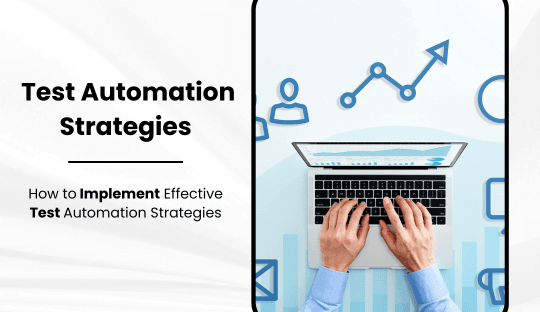
How to Implement Effective Test Automation Strategies
In the ever-evolving landscape of software development, implementing effective test automation strategies is crucial for ensuring quality and efficiency. For Flykez CO, a creative brand company in France, adopting robust test automation practices can significantly enhance their website design, development, SEO, brand identity, digital marketing, and UI/UX design services. This blog post outlines key strategies for successful test automation, leveraging the latest QA testing trends for 2024, hybrid testing models, mobile testing with 5G, multi-device testing, and AI in QA testing.
Understanding Test Automation
Test automation involves using specialized software to execute tests and compare actual outcomes with expected results. It is a critical component of the software development lifecycle, helping to improve accuracy, speed, and efficiency while reducing manual effort.
Key Benefits:
- Efficiency: Automates repetitive tasks, freeing up time for more complex testing activities.
- Accuracy: Reduces human error, ensuring more reliable test results.
- Coverage: Increases test coverage by enabling more tests to be run in less time.
Key Strategies for Effective Test Automation
1. Embrace QA Testing Trends 2024
Staying updated with the latest trends in QA testing is essential for implementing effective test automation strategies. The trends for 2024 highlight advanced methodologies and technologies that can significantly enhance the quality and efficiency of your testing processes.
Key Trends:
- AI in QA Testing: Utilize AI to automate repetitive tasks, detect anomalies, and predict potential issues.
- Hybrid Testing Models: Combine manual and automated testing to cover all aspects of the QA process.
- Mobile Testing with 5G: Leverage the capabilities of 5G to improve the efficiency and reliability of mobile testing.
- Multi-Device Testing: Ensure your products work seamlessly across various devices and platforms.
2. Define Clear Objectives and Scope
Before implementing test automation, it’s crucial to define clear objectives and the scope of your testing. This helps in identifying the key areas that need automation and aligning the testing goals with business objectives.
Steps:
- Identify Key Areas: Determine which tests to automate based on their frequency, complexity, and criticality.
- Set Objectives: Define clear objectives for your test automation efforts, such as reducing testing time, increasing coverage, or improving accuracy.
- Scope: Clearly outline the scope of automation, including which platforms, devices, and environments will be covered.
3. Select the Right Tools
Choosing the right automation tools is critical for the success of your test automation strategy. The tools should align with your testing requirements, be compatible with your existing systems, and support multiple platforms and devices.
Key Considerations:
- Compatibility: Ensure the tools support the platforms and technologies used in your projects.
- Ease of Use: Choose tools that are user-friendly and easy to integrate with your existing systems.
- Scalability: Ensure the tools can scale with your testing needs as your projects grow.
4. Develop a Robust Test Automation Framework
A test automation framework provides a structured approach to automate testing processes. It defines the guidelines, best practices, and tools used in the automation process, ensuring consistency and efficiency. Also Read About Building a Culture of Quality in Your QA Team
Key Components:
- Reusable Scripts: Develop reusable test scripts to reduce redundancy and improve efficiency.
- Modular Approach: Use a modular approach to separate test data, test scripts, and functions, making it easier to maintain and update.
- Integration: Integrate the framework with your CI/CD pipeline to enable continuous testing and faster feedback.
5. Implement Hybrid Testing Models
Hybrid testing models combine manual and automated testing to achieve comprehensive coverage and address the limitations of each approach. This ensures that all aspects of the application are thoroughly tested.
Key Benefits:
- Comprehensive Coverage: Covers both functional and non-functional aspects of the application.
- Flexibility: Allows testers to use the most appropriate method for each test case.
- Efficiency: Optimizes the use of resources by automating repetitive tasks and focusing manual efforts on complex scenarios.
6. Focus on Mobile Testing with 5G
With the advent of 5G technology, mobile testing has become more critical and complex. Leveraging the capabilities of 5G can enhance the efficiency and reliability of your mobile testing efforts.
Key Strategies:
- Performance Testing: Test the performance of your mobile applications under various network conditions.
- Real-Device Testing: Use real devices to test the functionality and performance of your mobile applications.
- Automation Tools: Utilize mobile automation tools like Appium and Selenium to automate your mobile testing efforts.
7. Ensure Multi-Device Testing
Ensuring that your applications work seamlessly across different devices and platforms is crucial for providing a consistent user experience.
Key Strategies:
- Cross-Browser Testing: Test your applications across different browsers and versions to ensure compatibility.
- Device Matrix: Develop a device matrix to cover a wide range of devices, including smartphones, tablets, and desktops.
- Responsive Design: Test the responsiveness of your applications to ensure they work well on different screen sizes and resolutions.
8. Leverage AI in QA Testing
AI can significantly enhance the efficiency and effectiveness of your QA processes by automating repetitive tasks, identifying patterns, and predicting potential issues.
Key Benefits:
- Automation: Automate repetitive tasks to free up time for more complex testing activities.
- Anomaly Detection: Use AI to detect anomalies and identify potential issues early.
- Predictive Analytics: Leverage AI for predictive analytics to anticipate and address issues before they occur.
Conclusion
Implementing effective test automation strategies is crucial for ensuring the quality and efficiency of your software development processes. By embracing the latest QA testing trends, defining clear objectives, selecting the right tools, developing a robust test automation framework, implementing hybrid testing models, focusing on mobile testing with 5G, ensuring multi-device testing, and leveraging AI, Flykez CO can enhance its QA efforts and deliver high-quality digital experiences. For more information on our services and to see how we can enhance your digital presence, visit Flykez CO.
